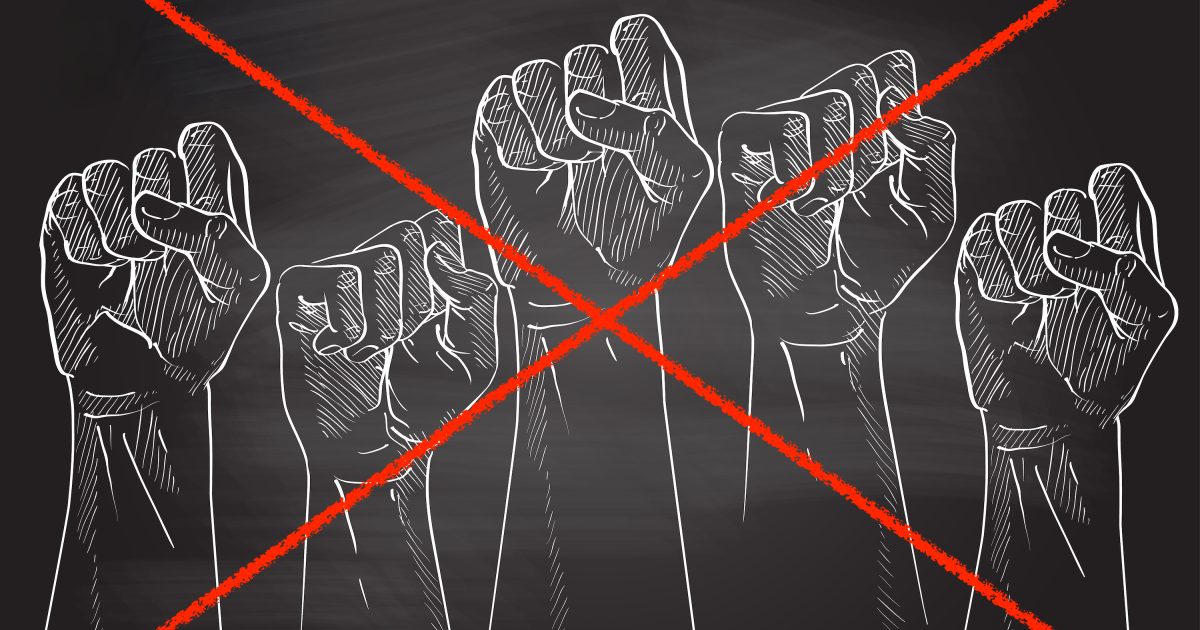Imagine wearing an “I Voted” sticker to class and having the school investigate you for it. Or handing out pocket editions of the Constitution on campus for Constitution Day, only for your school to deem this disruptive.
Martin Luther King, Jr. Day. Juneteenth. Labor Day. Columbus Day. Connecticut’s Trinity College seemingly prohibits on-campus celebrations of all these federal holidays. (Don’t even get us started on t-shirts that read “Reagan-Bush 1984” or “Nevertheless, She Persisted.”)
On November 7, individuals identifying with Students and Faculty for Justice in Palestine left chalkboard messages around campus while classes were out of session. These messages read, “Trinity is suppressing freedom of assembly,” “Disclose Divest Protest,” “Trinity Invests in Genocide,” “You are on stolen land,” and “Free Palestine.”
That evening, Trinity President Daniel Lugo emailed the campus community, announcing an investigation of the messages for disruption, intimidation, and harassment. Then came the anti-speech money quote: “Our Student Handbook and employment policies clearly prohibit political activism within academic settings.”
No nuance. No qualifiers. Just a blanket ban on political activism anywhere “academic.”
There’s only one problem. FIRE couldn’t find any such rule. In fact, Trinity’s official policies affirm the importance of free expression and academic freedom, and — to its credit — the school’s time, place, and manner rules largely track First Amendment standards. Although Trinity is a private college and not legally required to protect students’ First Amendment rights, it laudably promises to uphold students’ expressive freedom in its policies. So last week, FIRE wrote to Lugo, urging him to make good on these commitments.
FIRE calls on Trinity to end its investigation into the matter and remove any existing policy prohibiting “political activism within academic settings.”
Lugo’s letter said that the college community “deserves to teach, learn, and work in spaces free from intimidation, harassment, or disruption.” We certainly agree, but this letter errs in suggesting that the chalkboard messages should merit punishment. On the contrary, the after-hours commentary doesn’t come close to a material and substantial disruption. Even if they did, it still wouldn’t justify outlawing all political speech on campus.
The chalkboard messages weren’t harassment either. Harassment requires content so objectively offensive, pervasive, and severe that it effectively denies students equal access to education. There is no evidence these messages rise to this level of unprotected speech.
Nor are they intimidation. Unprotected intimidation (i.e. a true threat) requires a serious expression of intent to commit unlawful violence, and a conscious disregard of the potential for that expression to put its recipient in fear of serious physical harm. Again, nothing of the sort here.
Viral video appears to show Trinity College singling out one student’s political dorm display for removal
Without the freedom to express even inoffensive political convictions, the promise of free speech is meaningless. America’s colleges and universities cannot conceivably function as insulated vacuums for discussion on topics of national and international importance, especially in service of such a broad and spontaneous edict.
Political activism has always been part of campus life in the United States. Without it, groups from Students for a Democratic Society to Turning Point USA wouldn’t exist, and George Carlin’s most legendary, politically charged bits (including his landmark UCLA set) might never have happened.
Trinity’s overbroad language puts America’s long and proud tradition of fostering political engagement in jeopardy, and that is cause for alarm. Accordingly, FIRE calls on Trinity to end its investigation into the matter and remove any existing policy prohibiting “political activism within academic settings.”










